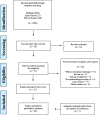Which resistance training is safest to practice? A systematic review
- PMID: 37046275
- PMCID: PMC10099898
- DOI: 10.1186/s13018-023-03781-x
Which resistance training is safest to practice? A systematic review
Abstract
Background: The combination of resistance training (RT) and aerobic training is believed to achieve the best effects. Several different aerobic training methods have emerged in combination with or as a substitute for traditional RT. This study wished to verify which RT is safest in terms of injury prevalence and incidence. Also, it ascertained the characteristics of the injured subjects, the level of severity of the injuries and what definitions of injuries the available studies use.
Methods: This systematic review followed the PRISMA recommendations and was registered in PROSPERO with the number CRD42021257010. The searches were performed in the PubMed, Cochrane and Web of Science, electronic databases using the Medical Subject Headings terms "Resistance training" or "Strength training" or "Crossfit" or "Weightlifting" or "Powerlifting" combined (AND) with "Injury" or "Injuries" or "Sprain" AND "Incidence" or "Prevalence" AND "Epidemiology" or "Epidemiological" in the title or abstract. The last search was performed on March 2023. To be included in the review, the studies had to be available as full text, be clinical trials focusing on epidemiological injuries of resistance training. There was no time limit for the selection of articles. To assess the quality of the studies, the Strengthening the Reporting of Observational Studies in Epidemiology (STROBE) was used.
Results: The initial literature search resulted in 4982 studies. After reading the titles, abstracts and full text, 28 articles were selected for data extraction. Seventeen investigated the injuries in HIFT/CrossFit, three in powerlifting, three in strength training, three in weightlifting and one in strongman. In addition, one study examined the HIFT/CrossFit and weightlifting. The incidence of injuries presented in the studies ranged from 0.21/1000 h to 18.9/1000 h and the prevalence of injuries was 10% to 82%. In the quality assessment for STROBE, five studies were classified at level A, 21 at level B and two at level C.
Conclusion: This systematic review showed that traditional strength training is the safest RT method, and strongman is the least safe regarding injuries. Few studies have been rated highly according to STROBE. Furthermore, few studies have been published on some RT methods. These two factors make it difficult to generalize the results.
Keywords: High-intensity functional training; Injury; Resistance training; Strength training; Weightlifting.
© 2023. The Author(s).
Conflict of interest statement
The authors declare that they have no conflicts of interest.
Similar articles
-
Injuries in weightlifting and powerlifting: an updated systematic review.BMJ Open Sport Exerc Med. 2024 Dec 4;10(4):e001884. doi: 10.1136/bmjsem-2023-001884. eCollection 2024. BMJ Open Sport Exerc Med. 2024. PMID: 39650568 Free PMC article.
-
Effects of balance training on post-sprained ankle joint instability.Int J Risk Saf Med. 2015;27 Suppl 1:S99-S101. doi: 10.3233/JRS-150707. Int J Risk Saf Med. 2015. PMID: 26639734
-
The Epidemiology of Injuries Across the Weight-Training Sports.Sports Med. 2017 Mar;47(3):479-501. doi: 10.1007/s40279-016-0575-0. Sports Med. 2017. PMID: 27328853 Review.
-
The Effects of Resistance Training on Muscular Fitness, Muscle Morphology, and Body Composition in Elite Female Athletes: A Systematic Review.Sports Med. 2023 Sep;53(9):1709-1735. doi: 10.1007/s40279-023-01859-4. Epub 2023 Jun 8. Sports Med. 2023. PMID: 37289331 Free PMC article.
-
Beyond the black stump: rapid reviews of health research issues affecting regional, rural and remote Australia.Med J Aust. 2020 Dec;213 Suppl 11:S3-S32.e1. doi: 10.5694/mja2.50881. Med J Aust. 2020. PMID: 33314144
Cited by
-
Injuries in weightlifting and powerlifting: an updated systematic review.BMJ Open Sport Exerc Med. 2024 Dec 4;10(4):e001884. doi: 10.1136/bmjsem-2023-001884. eCollection 2024. BMJ Open Sport Exerc Med. 2024. PMID: 39650568 Free PMC article.
References
-
- Medicine AC of S. American College of Sports Medicine position stand. Progression models in resistance training for healthy adults. Med Sci Sports Exerc 2002;34:364–80. - PubMed
Publication types
MeSH terms
LinkOut - more resources
Full Text Sources
Medical


